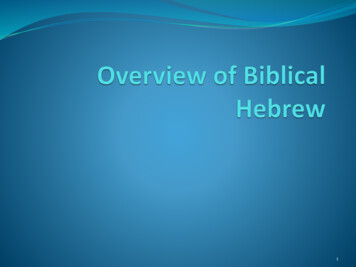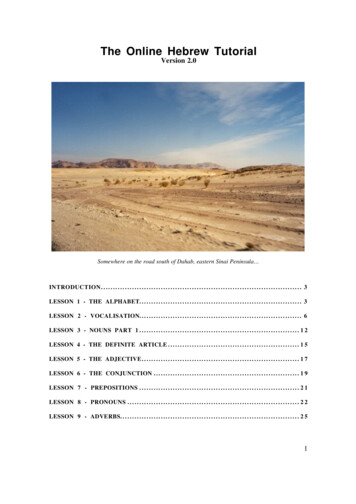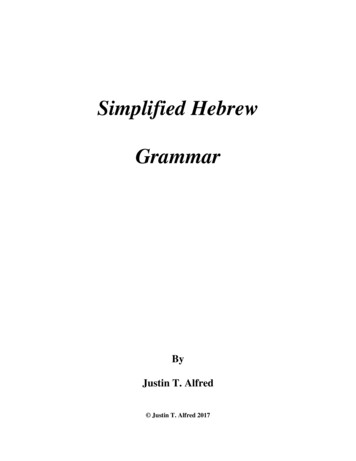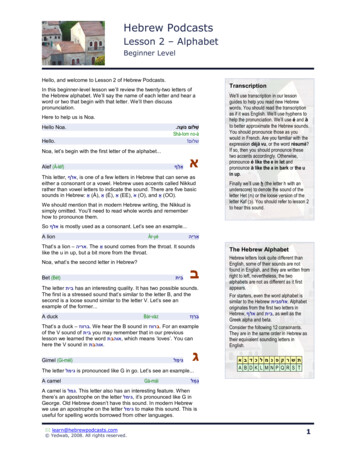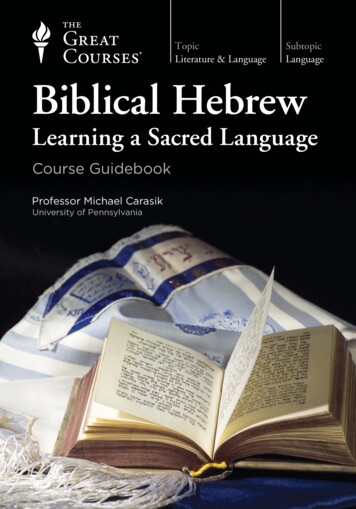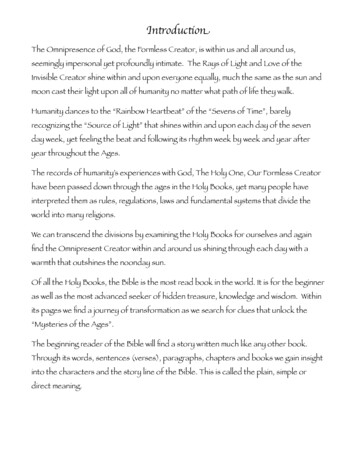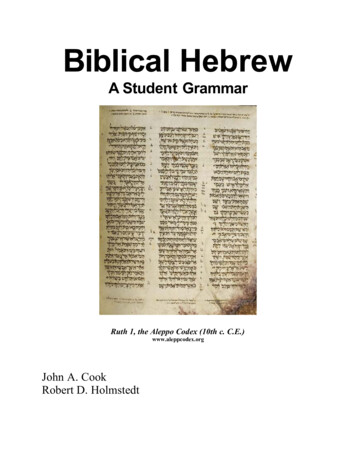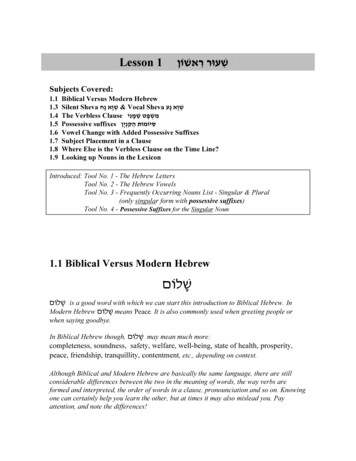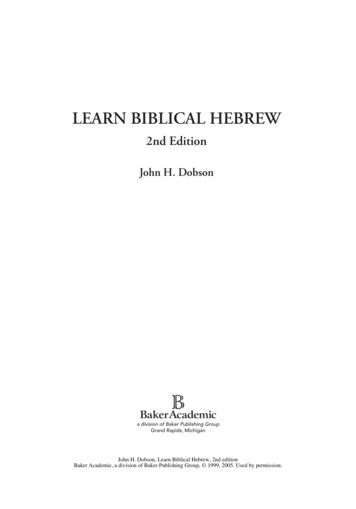
Transcription
LEARN BIBLICAL HEBREW2nd EditionJohn H. DobsonAn audio CD-ROM accompanies this book. KJohn H. Dobson, Learn Biblical Hebrew, 2nd editionBaker Academic, a division of Baker Publishing Group, 1999, 2005. Used by permission.Dobson LearnHebrewCopyright.indd 3LBH FINAL.indb 34/28/14 2:47 PM30/3/07 11:00:35 AM
1999, 2005 by John H. DobsonThis 2nd revised edition (updated) and audio CD-ROM copyright 2005 by Piquant Editions LtdPO Box 83, Carlisle, CA3 9GR, United Kingdomwww.piquanteditions.comFirst edition published in 1999 by SIL International (Dallas)This edition co-published in North America in 2005 by Baker Academica division of Baker Publishing GroupP.O. Box 6287, Grand Rapids, MI 49516-6287www.bakeracademic.comPaperback edition published 2014ISBN 978-0-8010-9742-3Printed in the United States of AmericaAll rights reserved. No part of this publication may be reproduced, stored in a retrieval system, or transmitted in any form or by any means—for example, electronic or mechanical, including photocopying orrecording—without the prior written permission of the publisher. The only exception is brief quotationsin printed reviews.British Library Cataloguing-in-Publication DataDobson, John H.Learn Biblical Hebrew. — Rev. 2nd ed.1. Bible. O.T.—Language, style 2. Hebrew language, Biblical—Grammar I. Title492.4p82421ISBN 10: 1-903689-25-2ISBN 978-1-903689-25-7Library of Congress Cataloging-in-Publication Data for the hardcover edition is on file at theLibrary of Congress, Washington, DC.ISBN 10: 0-8010-3102-8ISBN 978-0-8010-3102-1Quotations from the Hebrew Old Testament are from the Biblia Hebraica Stuttgartensia, published byDeutsche Bibelgesellschaft (1967/77, 1990).Cover design by ProjectluzBook design by 2aT (www.2aT.com)14151617181920 7654321John H. Dobson, Learn Biblical Hebrew, 2nd editionBaker Academic, a division of Baker Publishing Group, 1999, 2005. Used by permission.
Dedicated to my wife Heatherwith thanks for fifteen years ofunfailing encouragement and supportJohn H. Dobson, Learn Biblical Hebrew, 2nd editionBaker Academic, a division of Baker Publishing Group, 1999, 2005. Used by permission.
John H. Dobson, Learn Biblical Hebrew, 2nd editionBaker Academic, a division of Baker Publishing Group, 1999, 2005. Used by permission.
CONTENTSForeword by Anthony GelstonPrefaceAcknowledgementsixxixivIntroduction to Lessons 1–311. listen, Israel (Alphabet)2. in the beginning (Word Order in Sentences)3. he spoke . . . and he spoke to me21725Introduction to Lessons 4–6354. he killed and he killed (Narrative and Completed Action)5. good (Adjectives)6. he will kill he will give (Continuing Action)405060Introduction to Lessons 7–8737. word word of (Absolute and Construct Nouns)8. he will send and take (Previous and Future Action)7689Introduction to Lessons 9–131019. there is who (Possession and Questions)10. listen! go! (Commands and Requests)10911. number time (Numbers, Time, and Measurements)12. to keep (Infinitives)13. keeping (Participles)119129141149Introduction to Lessons 14–1715714. he was guarded, he took care (Niphal)15. he praised (Piel)16. he made king (Hiphil)17. he claimed to be great (Hithpael)18. Wishes, Oaths, and Conditions163173184199213viiJohn H. Dobson, Learn Biblical Hebrew, 2nd editionBaker Academic, a division of Baker Publishing Group, 1999, 2005. Used by permission.
Introduction to Lessons 19–2222619. and he killed (Narrative Forms: wa PC)20. Sentence and Clause Beginnings21. Perfective (SC) and Imperfective (PC) Verbs22. Sentence and Clause Sequences23. Translating Hebrew Poetry24. Prepositions25. Idioms and Areas of Meaning229241252262279295316Glossary of Grammatical TermsMasoretic Text–MTReference GrammarAppendix: Teaching Biblical HebrewSelected Subject IndexScripture IndexPassages to Read; Passages Translated; Index of Verses QuotedSelected Hebrew Word Index333351352373379383viiiLearn Biblical Hebrew391John H. Dobson, Learn Biblical Hebrew, 2nd editionBaker Academic, a division of Baker Publishing Group, 1999, 2005. Used by permission.
FOREWORDI am excited by the publication of Learn Biblical Hebrew. I have followed itsdevelopment with growing interest. It opens a doorway into the HebrewBible.The Hebrew Bible is one of the world’s greatest pieces of literature.It appeals to a wide variety of people who want to read and understandit for very different reasons. Most people first meet it in one of its manymodern translations, but a comparison of two or more of these quicklyreveals the fact that no translation can ever convey the full meaning of atext in a different language. To understand it fully and to enjoy the skill ofits poets, teachers, and prophets, one needs to learn the language in whichit is written. John Dobson’s book offers a new and effective way of learning.Learn Biblical Hebrew has been worked out over the last ten years in thecontext of a great deal of practical experiment and experience of teachinggroups of beginners. It has proved to be an effective help for people acrossa wide range of ages and cultures.John Dobson is singularly well equipped to carry out this task of makingHebrew understandable and enjoyable. Like many students he found theinitial learning of Hebrew difficult and discouraging. This experience hasgiven him a great desire to make learning easier for others. His backgroundis that of a classical scholar trained at Merton College, Oxford, who laterlearned the Lugbara language in Uganda. He has approached Hebrew withthe careful understanding of someone trained in language study. He has alsohad extensive experience of language teaching in Africa as well as in Europe.He has found a way of introducing Hebrew that gives people confidence toread actual passages of the Hebrew Bible from an early stage. One group ofstudents in Moscow, for instance, learned the basics of Hebrew from lessons1–17 and read the whole of Jonah in the course of only twelve days!The book makes expert use of many of the techniques of modernlanguage teaching, subtly modified to suit the task of learning an essentiallywritten language. Its careful structuring of grammatical forms andvocabulary to build up easy familiarity through repetition goes a long wayto ease the tedium that can so easily discourage a beginner.ixJohn H. Dobson, Learn Biblical Hebrew, 2nd editionBaker Academic, a division of Baker Publishing Group, 1999, 2005. Used by permission.
Another unusual and excellent feature of this course is the amount ofattention given throughout, but particularly in the later lessons, to thewide range of meanings of words, grammatical forms, and constructions.The importance of allowing the context of each passage to determine itsmeaning is brought out by a wide variety of illustrations from the biblicaltext, systematically grouped to give a comprehensive coverage of eachpoint.In the later lessons there is a stimulating introduction to Hebrew poetry,as well as an interesting section on idiomatic expressions. Much of thematerial goes beyond what is offered in usual grammars for beginners. Itcorresponds to what might be given by an enterprising college teacher ina second year class. The wealth of biblical material enhances the students’understanding and appreciation of the language, and builds up theirconfidence in reading it.As one who for some years taught biblical Hebrew to theological studentsin a British university, using at different times three teaching grammars, Ishould have welcomed and eagerly used this course had it been available tome at the time. Even students trying to learn biblical Hebrew on their own,without a tutor, will have a better chance of mastering it with this coursethan with any other known to me.I count it a privilege to have been invited to contribute this preface. Icommend the course to teachers and students without reservation.Anthony GelstonEmeritus Reader in TheologyUniversity of Durham, UKxLearn Biblical HebrewJohn H. Dobson, Learn Biblical Hebrew, 2nd editionBaker Academic, a division of Baker Publishing Group, 1999, 2005. Used by permission.
PREFACEWelcome to Learn Biblical HebrewThe books of the Hebrew Bible are a shared inheritance for Jews, Christians,and Muslims. From them people have learned to believe in one God whois the creator of all that exists. They contain passionate pleas for justice andfor the liberation of the oppressed. They introduce us to some of the world’sgreatest poetry and songs—and some of its deepest sorrows.Unfortunately, the treasures of these books are partly hidden from usbecause they are written in Hebrew. Fortunately, Hebrew is a language onecan learn to read quite quickly.Learn Biblical Hebrew is designed to enable you to read biblical Hebrew,to understand its structure, to build a basic vocabulary by reading wordsin meaningful passages, hearing them on the audio CD and using them ingames and activities, and to reflect on ways of translating Hebrew. An audioCD to accompany these lessons is provided with this book.Because Hebrew is a very different language, an effort is made not toconfine it too strictly within a net of English grammatical terms. It may bebest to work through the whole course at least once before consulting otherbooks. In this way confidence in reading Hebrew will be built up beforemore technical studies are undertaken.Enjoy your learning and take pleasure in your progress.How to use Learn Biblical HebrewLearn Biblical Hebrew has been structured so that you can study it on yourown, in a group or with a teacher. Many of the Hebrew sentences andpassages are written with an English translation beside them. This meansthat you can make progress without any fear of making serious mistakes.Learn Biblical Hebrew is also a useful textbook for teaching extensioncourses as well as residential courses and regular classes.You will find helpful further guidelines in the appendix on ‘TeachingBiblical Hebrew’ (p373).xiJohn H. Dobson, Learn Biblical Hebrew, 2nd editionBaker Academic, a division of Baker Publishing Group, 1999, 2005. Used by permission.
Preparation for studying a lessonFrom lesson 2 onwards use the audio CD to review the lesson you haverecently done and to listen to the key parts of the next two lessons you willbe studying. Look at the wordsearch at the end of the last lesson you did,and the one at the end of the lesson you are going to study.Studying the lessonRead each section, looking at the English and the Hebrew. Then cover theEnglish column. Read the Hebrew. After each sentence, uncover the Englishto check that you have arrived at a similar meaning. If you come across aHebrew word you cannot remember, read the whole sentence. If this doesnot provide a clue to its meaning, uncover the check column immediatelyto find out its meaning. Highlight the word. After each lesson, later in theday or on the next day, do the activations.Move forward as fast as you can. If questions arise in your mind, you willusually find an answer later in the course. Press ahead!Note that after many of the grammatical terms used in the text, I haveadded, in brackets, the most common abbreviations used. Many terms areexplained in the glossary at the end of the book.ProgressIf you do three lessons a week, you will complete the course in about twomonths. At one lesson a week it takes only six months. It is probably bestto work through the whole course once before you attempt to write wordsin Hebrew.Using the audio CDListening is a very important part of language learning. When we are veryyoung, we listen to our parents saying, ‘Mummy’ and ‘Daddy’ many timesbefore we begin to say ‘Mummy’ and ‘Daddy’. The audio CD helps youto listen to most of the Hebrew in lessons 1–13, usually with an Englishtranslation read just before the Hebrew.The audio CD is an important part of the course. As you listen, you willlearn.Use the audio CD to revise each lesson from 1 to 13. Sit and listen to theaudio CD. Then look at the book and see if you can read the Hebrew whileyou listen. Use your finger or a pointer to help your eyes focus on the words.Do not be worried if at first you cannot read Hebrew words as quickly asthey are spoken on the audio CD. You will gain fluency with practice.Use the audio CD to prepare each lesson. Listen to the CD before youxiiLearn Biblical HebrewJohn H. Dobson, Learn Biblical Hebrew, 2nd editionBaker Academic, a division of Baker Publishing Group, 1999, 2005. Used by permission.
begin to study the lesson. You do not need to try to learn anything. The actof listening attentively will help your brain to begin to gather informationthat will make the lesson easier when you begin to study it.When you listen to the instructions on the audio CD, you will sometimeshear the words, ‘Listen as people speak.’ this is to alert you to the fact thatsome sentences in the exercises have a structure more typical of spokenHebrew,whetherpoetry,sectionsof prosebeginto studythe proselesson.orYoudo notthanneedoftowrittentry to oninanarrative.of listening attentively will help your brain to begin to gather informationthatPublisher’swill make thelessoneasier whenyou ofbeginstudy uded aSomeusefulbooksWhen containingyou listen toaudiothe instructionson theCD,experience.you will sometimesCD-ROMfiles to enhancetheaudiolearningThis anaudioCD.TheaudiofilesarenowavailDictionaries and Lexiconssomesentencesin the exercises have a structure more typical Referencesof spokenable onlineat dson, B. Analytical Hebrew and Chaldee Lexicon. Peabody, tionsofprosethatto “website”Hendrickson, lladay,A. seeA ConciseLexicon of the Old Testament.Grand Rapids, Mich.: Eerdmans, 1972Someuseful booksLangenscheidt.Pocket Hebrew Dictionary to the Old Testament. 1988DictionariesGrammar and LexiconsDavidson,Hebrew andLexicon.Peabody,Mass.:Waltke, B. B.K.,Analyticaland M. O’Connor.AnChaldeeIntroductionto BiblicalHebrewSyntax.Hendrickson,1984Winona Lake, Ind.: Eisenbrauns, 1990Holladay, W. A. A Concise Hebrew and Aramaic Lexicon of the Old Testament.TextualCriticismGrandRapids, Mich.: Eerdmans, 1972Tov,E.Textualof the ismPocket HebrewDictionaryto Minneapolis,the Old Testament.Press, 1992GrammarHebrew Poetry and NarrativeWaltke, B. K., and M. O’Connor. An Introduction to Biblical Hebrew Syntax.Alter,R. TheLake,Art ofInd.:BiblicalNarrative. 1990New York: Basic Books, 1983WinonaEisenbrauns,Alter, R. The Art of Biblical Poetry. New York: Basic Books, 1987Textual CriticismKugel, J. The Idea of Biblical Poetry. New Haven: Yale University Press, 1981/Tov,Baltimore:E. Textual JohnsCriticismof the UniversityHebrew Bible.Minneapolis,Minn.: FortressHopkinsPress,1998Press, 1992Watson, W. G. E. Classical Hebrew Poetry. Sheffield Academic Press, 1995HebrewPoetryandNarrativethe Psalms. Dallas, Texas: Summer Institute ofWendland,E. R.AnalyzingAlter,R. The Art1998of Biblical Narrative. New York: Basic Books, 1983Linguistics,Alter, R. The Art of Biblical Poetry. New York: Basic Books, 1987Kugel, J. The Idea of Biblical Poetry. New Haven: Yale University Press, 1981/Baltimore: Johns Hopkins University Press, 1998Watson, W. G. E. Classical Hebrew Poetry. Sheffield Academic Press, 1995Wendland, E. R. Analyzing the Psalms. Dallas, Texas: Summer Institute ofLinguistics, 1998PREFACExiiiJohn H. Dobson, Learn Biblical Hebrew, 2nd editionBaker Academic, a division of Baker Publishing Group, 1999, 2005. Used by permission.LBH FINAL.indb 13Dobson LearnHebrewCopyright.indd 630/3/07 11:00:36 AM4/28/14 3:56 PM
ACKNOWLEDGEMENTSI thank Sandie Schagen who first suggested that I should write Learn BiblicalHebrew, and Katy Barnwell of SIL who said, ‘We will publish it;’ also JohnAusting who typed the first manuscript; Carl Follingstad who checked itand made useful suggestions; Dick Blight who edited it and prepared itfor printing; and my advisors and checkers Walter Houston, John Job, andNicola Pinn. My Ugandan students William Pashi and Benjamin Twinamaaniwho in 1989 said, ‘This is how we want to learn Hebrew’, and my students inMoscow who in twelve days did seventeen lessons and read Jonah, and said,‘We never knew it would be so much fun’, encouraged me enormously.I thank SIL (British branch) for opportunities to teach; Rina Hazony forher enthusiastic interest; Derek Kidner who guided my first steps in Hebrew;and Anthony Gelston who has so willingly contributed the Foreword. Mythanks also to Pieter Kwant and his team at Piquant for preparing this secondedition. I am grateful to Dr Robert Stallman for checking the new material inthis edition, and to him and to Rev John Job for help with proofreading.Thanks to those teachers who have been very keen to study my teachingmethods—especially to Dr Robert Stallman of Northwest University, Kirkland,Seattle and to the Rev Justus Mbogo of St Andrews College, Kabare, Kenyawho have travelled to the UK to observe my courses and who report newenthusiasm from their classes. My thanks also to the Bible Society of Kenyaand the Bible Society of Pakistan who have given me the opportunity to runcourses for their Bible translators, and to the Rev Jerald Mall in Karachi whohas shown such a keen interest in my books and teaching methods andwho hopes to translate them into Urdu, and to Dr Victor Zinkuratire of theCatholic University of Eastern Africa who greeted the appearance of LearnBiblical Hebrew with enormous joy.To you all John H. DobsonxivJohn H. Dobson, Learn Biblical Hebrew, 2nd editionBaker Academic, a division of Baker Publishing Group, 1999, 2005. Used by permission.
INTRODUCTION TO LESSONS 1–3Hebrew we may already know(a) Hallelujah! Amen. Cherub, cherubim. Seraph, seraphimHallel—praise! Amen—truly, so be it. Cherub—a heavenly being. Seraph—a heavenly being (a burning bright one). Cherubim and seraphim meanthere is more than one, so we already know one indicator that a Hebrewword is plural.(b) Ben and BathBen Hadad means Son of Hadad. Bath Sheba is Daughter of Sheba.(c) Hebrew names give us a clue to several words:Nathan ( ): Giver ( ‘he gave’) ( is a long )Michael ( [ ’ ): Who is like God ( ‘like’, ‘God’)Ishmael ( ): Let God hear ( ‘God’, [ ] ‘let himhear’)Emmanuel ( ): God is with us ( ‘God’, ‘withus’).(d) Matthew 27:46 : My God, my God, why ? means ‘God’. means ‘my God’. You can see that an added indicates ‘my’.We already hold in our hands some important keys to unlock Hebrew.Lessons 1–3In Lesson 1 you will learn to read Hebrew letters and some Hebrew words.You will read Deuteronomy 6:4.In Lesson 2 you will read Genesis 1:1 and begin to see the structure ofHebrew sentences and narrative.In Lesson 3 you will learn, ‘to me, to you, to him, to her’ and ‘to us, toyou, to them.’ You will notice some ways that Hebrew sentences are linkedtogether.So in about four hours you will have taken some important steps alongthe road towards learning to read Hebrew.1John H. Dobson, Learn Biblical Hebrew, 2nd editionBaker Academic, a division of Baker Publishing Group, 1999, 2005. Used by permission.
Lesson 1 ( )Alphabet listen, Israel1.1 Right to left Hebrew is read from right to left Here is an English sentence written from right to left: AM IXAT A MA I When you see a Hebrew word, read it from the right end!Note:(a) ‘Ben’ is Hebrew for ‘son of’. It begins with ‘b’. Notice the in . The short ‘e’ sound is shown by under the (b) ‘Bat’ or ‘Bath’ is ‘daughter of’. It ends with ‘t’ or ‘th’. Notice the in . The short ‘a’ sound is shown by under the (c) ‘Melekh’ is Hebrew for ‘king’. Notice ‘m’ and ‘l’ and ‘kh’in In this lesson you will find some guidelines for pronouncing words in biblicalHebrew. They are not rules. In different places and in different ages therehave been varieties of pronunciation. We have already seen that may bepronounced as ‘t’ or ‘th’.If you work with a teacher, it will be best to copy the teacher’s way ofpronouncing Hebrew. If you are working on your own, use the pronunciationon the audio CD. However, if you know some modern Hebrew, you maywant to pronounce your biblical Hebrew in a way that is more like modernHebrew.1.2 Vowels and consonantsIn English, the letters a, e, i, o, and u are called vowels. Other letters arecalled consonants: b, c, d, f, and g are consonants. ‘Y’ may be a vowel, as in‘by’, or a consonant, as in ‘you’.When the biblical books were first written in Hebrew, it was the customto write only the consonants. Without vowels this sentence would be:WHN TH BBLCL BKS WR FRST WRTTN N HBRWT WS TH CSTM T WRT NL TH CNSNNTS2John H. Dobson, Learn Biblical Hebrew, 2nd editionBaker Academic, a division of Baker Publishing Group, 1999, 2005. Used by permission.
Later on, some Hebrew scribes used the letters ‘y’ and ‘w’ to indicatesome vowels. The next stage was to make marks under or over eachconsonant to show what vowel sound followed each consonant. In 1.1we saw [ ], in which under the is a short [ ], in which under the is a short and [ ], in which a short e is under ‘m’ and ‘l’.In Hebrew words, almost every syllable begins with a consonant. is pronounced , and not .1.3 Reading Hebrew wordsIn this lesson we shall learn to read Hebrew words. To help us to learn quicklywe shall, to begin with, use groups of Hebrew letters that sound somethinglike English words. These groups of letters are not Hebrew words. But somegroups will represent Hebrew words; and after the sound has been made,they will be repeated with an English meaning beside them. This will enableyou to read some real Hebrew words. They are a reading exercise—do notspend any time trying to learn their meanings. You will learn the meaningsof words when you see them in meaningful contexts as you go on throughthe course.1.4 The Hebrew letters and the vowel signs (a), (e), (i) with the letter Read these groups of Hebrew letters noting the equivalent sounds in English.A short a or e will be written or ; a long a or e will be written as or . as in bell as in gate as in doorRead Hebrew as in bat as in heave(often silent at the end of a word) Lesson 1John H. Dobson, Learn Biblical Hebrew, 2nd editionBaker Academic, a division of Baker Publishing Group, 1999, 2005. Used by permission.3
as in pet as in wellIn modern Hebrew, this letter isoften pronounced ‘v’ v as in zeal v v v v ‘this’ as in pit as in loch(like ch in German ach with aguttural sound) v v v - When ends a word, is pronounced and not You can now read one third of the Hebrew alphabet: [v] 4 Learn Biblical Hebrew John H. Dobson, Learn Biblical Hebrew, 2nd editionBaker Academic, a division of Baker Publishing Group, 1999, 2005. Used by permission.
When and do not have a dot in them, their sounds are softer.In the transliteration, a line below or above an English letter indicates thesoftening: as in over as in food as in gate As we go on you will notice a similar softening in: as in Bach as in awful as in footNote that in biblical Hebrew was probably pronounced as a soft dhrather like the ‘th’ in ‘rather’; and rather like the ‘th’ in ‘think’.1.5 The Hebrew letters and the vowel signs as in tip and v ve v , v as in father(The modernpronunciationis shorter.) v v , v v v the letter ‘festival,feast’ ‘hetrusted ’Lesson 1John H. Dobson, Learn Biblical Hebrew, 2nd editionBaker Academic, a division of Baker Publishing Group, 1999, 2005. Used by permission.5
as in yellow as in machine v ‘alive’ ‘hand’ ‘he was,it was ’ ‘in me’ ‘sinew’ ‘mud’ as in king as in Bach - (last letterof a word) ‘bucket, jar’ as in liner as in mail (last letterof a word)6 ‘in you’ ‘he wept ’ ‘because ’ ‘mist’ ‘night’ ‘to you’ ‘Babel,Babylon’ ‘to me’ ‘who?’ ‘king’ ‘what?’ ‘blood’ ‘camel’ ‘bread’Learn Biblical HebrewJohn H. Dobson, Learn Biblical Hebrew, 2nd editionBaker Academic, a division of Baker Publishing Group, 1999, 2005. Used by permission.
You can now read half the Hebrew alphabet! You have read: ‘Babylon’‘he trusts’‘in me’‘in you’‘he wept’‘sinew’ ‘camel’‘blood’‘he was’‘this’‘festival’‘mud’ use’‘bread’ ‘to me’‘night’‘to you’‘what?’‘who?’‘king’There are five letters which have a different form when they come at theend of a word. You have seen and . Note the others as you cometo them in 1.7–8:Beginning or middleof a wordEnd of a word [f ] [ts] 1.6 AlephThe letter Aleph is not sounded in the same sort of way that other consonantsare. It indicates a momentary stopping of the flow of breath—it is a glottalstop. It is like the tiny pause in the middle of the word ‘sea-eagle’. WhenHebrew words are written in English letters, may be represented by Lesson 1John H. Dobson, Learn Biblical Hebrew, 2nd editionBaker Academic, a division of Baker Publishing Group, 1999, 2005. Used by permission.7
glottal stop as inuh’oh(silent whenword final) ‘father’ ‘the father’ ‘he ate’ ‘one’ ‘hesinned’ ‘thebrother’1.7 The Hebrew letters and the vowel marks as in they as in noose (last letterof a word) as in sell ‘Go!’ ‘king’ ‘where?’ ‘hundred’ ‘stone’ ‘ear’ ‘he built’ ‘he pitied’ ‘garden’ ‘prophet’ ‘he forgave’ ‘loyal love,mercy’8 ‘Sinai’ ‘he wentround’Learn Biblical Hebrew ‘testing’ ‘throne’John H. Dobson, Learn Biblical Hebrew, 2nd editionBaker Academic, a division of Baker Publishing Group, 1999, 2005. Used by permission.
or or as in bowl ‘secret’ ‘all, every’ ‘to come’ (a slightly raspysound in the back ofthe throat, like thestart of a gargle) ‘day’ ‘to him’ ‘not’ ‘on’ ‘he served’ v ‘alive’ ‘she’ ‘good’ ‘good’ ‘tent’ ‘master’ ‘servant’In post-biblical times was often not pronounced, so in English translationsyou may not find any sign of it. For example, in Jeremiah 38 we find thename ‘servant of the king’. In English it is Ebed-melech. as in pet [f ]as in awful - (last letterof a word) ‘that not, lest’ ‘mouth’ ‘palm of hand’ as in flute ‘birds’‘to rest’ ‘here’ ‘heart’ ‘face’ Lesson 1 ‘to pour out’‘to flee’ ‘birds’ ‘mother’ ‘he added’ ‘he’‘she’John H. Dobson, Learn Biblical Hebrew, 2nd editionBaker Academic, a division of Baker Publishing Group, 1999, 2005. Used by permission.9
1.8 Dots within a letterYou have now read three quarters of the Hebrew alphabet, and you haveseen that is ‘he’ and is ‘she’!You have also seen that when and have an addeddot, it marks the letter as being hard: b, , , , , and .Some English writers indicate the softer sound by an added h, others by aline: or .After a vowel sound, a hard letter usually becomes soft, unless there is apause or punctuation. Note and . Both begin with ahard b. [for forms like see 1.10(b)]So ‘he trusted in you’, but, if we
because they are written in Hebrew. Fortunately, Hebrew is a language one can learn to read quite quickly. Learn Biblical Hebrew is designed to enable you to read biblical Hebrew, to understand its structure, to build a basic vocabulary by reading words in meaningful


